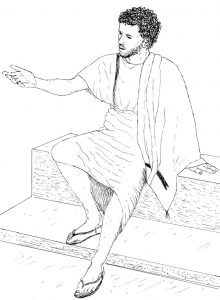O Natal deve ser olhado como uma mensagem política ousada dos cristãos ao dizer que é preciso confiar em Deus e resistir ao império.
Christmas is intended to be a bold political profession by Christians to trust God and to resist empire.
O Natal é a história da promessa de Deus de derrotar os poderes do mal. O Natal nos lembra que Jesus nasceu para resgatar as pessoas da tirania do poder imperial.
Christmas is the story of God’s promise to defeat evil powers, Jesus born to rescue people from tyrants, resistance to imperial powers and faithfulness in the face of empire.
O verdadeiro significado do Natal: Confie em Deus, resista ao império!
The true meaning of Christmas: Trust God, resist empire! – By Michael F. Bird: The Washington Post – Dec. 24, 2019
When most people think of the message of Christmas, they normally think about angels, wise men, shepherds, joy to the world, peace and goodwill, and “to us a child is given.” True, Christmas celebrates the incarnation of the Son of God as a baby born to a Galilean teenage girl named Mary in Bethlehem. Christmas is indeed a time to celebrate God’s blessings and peace to all.
But there is another side to Christmas! Christmas is the story of God’s promise to defeat evil powers, Jesus born to rescue people from tyrants, resistance to imperial powers and faithfulness in the face of empire.
powers and faithfulness in the face of empire.
Take the nativity story in the Gospels of Matthew and Luke.
According to Matthew, Jesus is a new Moses, born to save the people from their sins (Matthew 1:21). He delivers them from Herod, the ruthless Roman puppet king of Judea, who acts like the old Pharaoh in the massacre of infants in his desperation to murder the child destined to replace him as king of the Jews (Matthew 2:1-18). Whereas Herod turned the land of Judea into a place of misery and weeping, Jesus will lead his people in a new return from exile, a new escape from a wicked king, and into a new promised land called “the kingdom of heaven.”
Luke takes an explicitly political approach to the Christmas story. Luke situates the birth of Jesus in the context of a decree by Caesar Augustus for families of the empire to register for a census (Luke 2:1-3). Setting up the story this way, Luke immediately challenges us as to who we think is in charge of the world.
Is it Rome’s son of the divine Julius Caesar or Israel’s son of David? Rome’s Caesar or Israel’s Messiah? Rome’s Sebastos, the venerable one or Israel’s Christos, the anointed one? In particular, the various songs and prophecies uttered by characters in Luke’s nativity make explicit that God’s purposes in Jesus, summarized as “the kingdom of God,” entail social and political liberation from exploitative foreign powers.
Mary’s famous Magnificat could be the manifesto for a Marxist guerrilla group. She celebrates how, “God has brought down rulers from their thrones but has lifted up the humble. He has filled the hungry with good things but has sent the rich away empty” (Luke 1:52-53).
For Matthew and Luke, the nativity story is not meant to occasion our “oohs” and “aahs” at cute babies and 6-year olds dressed as wisemen and shepherds. Rather, the nativity is hope for justice, deliverance, and redemption in a world run by predatory empires. Christmas for the evangelists marks the beginning of God’s revolution to make things on earth as they are in heaven all through the son of Mary.
The anti-empire script of Christmas is accented by John of Patmos in his apocalypse, which unveils God’s plan to defeat the Roman empire and to replace it with the reign of his Messiah. This book, The Revelation of St. John, is not a coded mystery of the end times that religious enthusiasts of the 21st century unravel for us. More properly, Revelation shows us what the Roman empire looks like from the perspective of those under its lash, under its boot, and facing the threat of imperial violence. Revelation, as a Jewish apocalypse, is a symbolic species of writing that uses metaphor and marvel to describe in cryptic insider language how God will triumph over the pagan powers of the reader’s day.
How does John describe the nativity? Imagine this: A woman is in the final throes of childbirth, screaming in agony, her legs spread apart, ready to expel the baby from the birth canal. And waiting there with her is a dragon, poised, hungry, leaning over her, eagerly waiting to devour whatever is ejected from her loins. Yet the child escapes from the dragon and he soon rules over the nations with an iron scepter. Sound weird? Well, this is the Christmas story of John as narrated in Revelation 12!
The scene depicts the cosmic battle between the forces of evil and the hosts of heaven as the context for the birth of Jesus. The woman in question is not Mary, rather, she is the messianic community through whom Jesus is birthed. The child is obviously the Messiah, hence the citation of Psalm 2:9 about his rule over the nations. The removal of the child from the dragon is allusive of Jesus’ ascension and exaltation.
Importantly Jesus’ birth and the blood that he sheds as the Lamb of God constitutes the victory of God’s salvation, power, and kingdom over the evil one. In John’s vision, God’s plan to repossess the world from the dominion of darkness is launched in the birth of a child who is destined to defeat the dragon that rages against God’s people.
For the faithful, Christmas is a celebration that God is for us, God is near us, because God was one of us. God comes to us, in the vulnerability of child, to save us from our sins, and to rescue us from the evil forces that oppress us.
Christmas promises us that the despots of this age, political or spiritual, are living on borrowed time. The Christmas story is God’s answer to all the evil, injustice, brutality, suffering and death that we see around us.
Christmas is not meant to be about cheap trinkets for consumer religion. Rather, it is the annual reminder that God’s liberating love will always find us in the darkest corners of the world. Christmas is intended to be a bold political profession by Christians to trust God and to resist empire.
Michael F. Bird is academic dean of Ridley College in Melbourne, Australia, and senior research fellow with the Australian College of Theology.
Twelve important things to keep in mind about the Christmas stories – By Andrew Perriman: 20 December, 2019
Doze coisas importantes sobre as histórias de Natal que devem ser lembradas:
1. Sejamos francos. O Natal não tem nada a ver com Deus vindo à terra como um bebê indefeso para salvar a humanidade do pecado etc. Isso é outra questão, não é o que está sendo dito, não é o tema das histórias de Mateus e Lucas. Estes narram o nascimento de um rei que livrará Israel do século I d.C. de uma crise nacional. Quando o anjo diz a José que o filho de Maria “salvará o seu povo dos seus pecados” (Mt 1,21), ele quer dizer que Jesus salvará Israel das transgressões sócio-político-religiosas concretas que levaram a nação à beira da catástrofe.
 2. A pergunta-chave a ser feita sobre a concepção virginal de Jesus não é “Isso aconteceu?” Mas “O que isso significa?” Nem Mateus nem Lucas o entenderam como o processo metafísico pelo qual Deus se tornou homem. Antes, torna o nascimento de Jesus um notável “sinal” profético das coisas vindouras.
2. A pergunta-chave a ser feita sobre a concepção virginal de Jesus não é “Isso aconteceu?” Mas “O que isso significa?” Nem Mateus nem Lucas o entenderam como o processo metafísico pelo qual Deus se tornou homem. Antes, torna o nascimento de Jesus um notável “sinal” profético das coisas vindouras.
3. Sinal de quê? Está no nome “Emanuel”. Durante a guerra siro-efraimita no século VIII a.C., Isaías disse a um nervoso rei Acaz que um menino nasceria de uma jovem da corte real que receberia o nome de Emanuel, que significa “Deus conosco”. A mera existência dessa criança com nome significativo seria um “sinal” para Acaz de que a aliança entre Razon e Pecah falharia e que Iahweh protegeria Jerusalém dos assírios (Is. 7,10-17; 8,5-10). O nascimento do menino, portanto, foi um sinal de que Deus está com seu povo em um momento de grande crise política. O mesmo para o menino Jesus, que não recebeu o nome de Emanuel, mas um nome que significa “Iahweh é a salvação” (Mt 1,21).
4. Lucas dá um toque profético diferente à concepção miraculosa de Jesus. A criança que nascer será chamada não de Emanuel ou mesmo de Jesus, mas de “santo, Filho de Deus”. Com isso ele não quer dizer que Jesus é a segunda pessoa da Trindade ou Deus encarnado, embora isso possa ser verdade em certo sentido, mas que ele é o rei davídico que trará paz a um povo sob ocupação romana e governará a casa de Jacó para sempre (Lc 1,32-33.35; 2,1.11.14).
5. Eu me pergunto se Lucas também não está indicando a seus leitores a descrição de Isaías de uma Jerusalém restaurada quando ele diz que o Espírito virá sobre e cobrirá (episkiasei) Maria, e que a criança será chamada de “santa”: naquele dia, o que ficar em Jerusalém “será chamado santo, todos os que foram inscritos para a vida”, porque o Senhor lavará a imundície do seu povo; então ele virá, e como uma nuvem “encobrirá” (skiasei) a cidade (Is. 4,2-6, segundo a LXX).
6. Maria espera que Deus cumpra sua promessa a Abraão e ajude Israel neste momento de grave crise, dispersando os orgulhosos, derrubando os poderosos de seus tronos, levantando os miseráveis e humildes, enchendo de bens os famintos e mandando embora os ricos de mãos vazias (Lc 1,51-55). Simeão diz que “este menino é designado para a queda e o levantamento de muitos em Israel, e para sinal de contradição…” (Lc 2,34). Essa foi uma conversa inflamatória e revolucionária.
7. Pessoas como Zacarias e Isabel, Simeão e Ana, precisam de salvação não por causa de seus próprios pecados, mas por causa dos pecados da nação. Estas são pessoas justas, mas estão sofrendo as consequências da desobediência voluntária de um povo que está caminhando a largos passos para a destruição.
8. Para o sacerdote Zacarias, a redenção de Israel significa simplesmente que ele pode continuar servindo a Deus no Templo sem temer por sua vida (Lc 1,68-75). Mas ele sabe que a redenção começará com um julgamento devastador contra um sacerdócio corrupto (Lc 1,76; cf. Ml. 3,1). A profetisa Ana espera nada mais nada menos do que a “redenção de Jerusalém” (Lc 2,38).
9. Enquanto a história da visita dos Magos é contada em oposição a Herodes Magno, o anúncio angélico aos pastores soa como propaganda anti-imperial (Lc 2,8-14). A Inscrição do Calendário de Priene, celebrando o nascimento do deus Augusto, é agora bastante conhecida:
“Considerando que a Providência, que regulou toda a nossa existência … levou nossa vida ao clímax da perfeição ao nos dar Augusto, a quem encheu de força para o bem-estar dos homens e que, sendo enviado a nós e a nossos descendentes como Salvador, colocou um fim à guerra e colocou todas as coisas em ordem; e tendo se tornado [deus] manifesto, César cumpriu todas as esperanças dos tempos anteriores… superando todos os benfeitores que o precederam… e considerando que, finalmente, o dia do nascimento do deus [Augusto] foi para o mundo inteiro o começo das boas novas (euangeliōn) a respeito dele….”
10. O menino Jesus é aclamado como o rei davídico que, no mínimo, derrubará um regime injusto, libertará seu povo da opressão, trará paz e justiça a Israel e restaurará a reputação internacional da nação – para que reis, magos e povos venham prestar homenagem. Esta foi a boa notícia.
11. José e Maria provavelmente ficaram com a família em Belém. Com o quarto de hóspedes (katalumati) já ocupado ou muito pequeno, Jesus nasce nas baias dos animais sob a sala principal e é colocado no comedouro. Isso será um sinal para os pastores (Lc 2,12). Por que? Talvez porque Isaías diga que “o jumento conhece a manjedoura do seu dono”, mas Israel não conheceu o Senhor (Is. 1,3, segundo a LXX); ou porque Jeremias diz que quando Jerusalém for restaurada, “haverá novamente neste lugar que é deserto e em todas as suas cidades, alojamentos (katalumata) de pastores guardando ovelhas” (Jr. 40,12 , segundo a LXX). Mais uma vez, uma mensagem revolucionária.
12. Simeão diz que viu a salvação que Iahweh preparou “na presença de todos os povos, luz para revelação aos gentios e para glória do teu povo Israel” (Lc 2,31–32). O que ele quer dizer é que o julgamento vindouro e a restauração de Israel revelarão o poder do Deus de Israel às nações e que isso trará glória e renome a Israel. Isso fica claro pela alusão a Is 52,10: “O Senhor desnudou seu santo braço diante dos olhos de todas as nações, e todos os confins da terra verão a salvação de nosso Deus”. Quando Deus redimir seu povo do cativeiro na Babilônia e trazê-lo de volta à terra, as nações verão e se maravilharão com esse extraordinário ato de salvação.
Dada a má reputação da Igreja e do Deus da Igreja no Ocidente hoje, sinto que precisamos de outro ato de redenção que gere maravilhas.
1. Let’s be blunt. Christmas has nothing to do with God coming to earth as a helpless babe to save humanity from sin, etc. That is another matter, it’s not what’s being said, it’s not the burden of the stories in Matthew and Luke. These narrate the birth of a king who will deliver first century Israel from a national crisis. When the angel says to Joseph that Mary’s son will “save his people from their sins” (Matt. 1:21), he means that Jesus will save Israel from the concrete social-political-religious transgressions that have brought the nation to the brink of catastrophe.
2. The key question to ask about the virgin conception of Jesus is not “Did it happen?” but “What did it mean?” Neither Matthew nor Luke understood it as the metaphysical process by which God became man. Rather it makes Jesus’ birth an outstanding prophetic “sign” of things to come.
3. A sign of what? It’s in the name “Immanuel”. During the Syro-Ephraimite war in the 8th century BC, Isaiah told a nervous king Ahaz that a boy would be born to a young woman in the royal court who would be given the name Immanuel, which means “God with us”. The mere existence of this significantly named child would be a “sign” to Ahaz that the alliance between Rezin and Pekah would fail and that YHWH would preserve Jerusalem from the Assyrians (Is. 7:10-17; 8:5-10). The birth of the boy, therefore, was a sign that God is with his people at a time of great political crisis. Same for the boy Jesus, who is not given the name Immanuel but a name meaning “YHWH is salvation” (Matt. 1:21).
4. Luke puts a different prophetic spin on the miraculous conception of Jesus. The child being born will be called not Immanuel or even Jesus but “holy, Son of God”. By this he means not that Jesus is the second person of the Trinity or God incarnate, true though that may in some sense be, but that he is the Davidic king who will bring peace to a people under Roman occupation and will rule over the house of Jacob for ever (Lk. 1:32-33, 35; 2:1, 11, 14).
5. I wonder if Luke is not also pointing his readers to Isaiah’s description of a restored Jerusalem when he says that the Spirit will come upon and overshadow (episkiasei) Mary, and that the child will be called “holy”: on that day, what is left behind in Jerusalem “will be called holy, all who have been recorded for life”, because the Lord will wash away the filth of his people; then he will come, and as a cloud will “overshadow” (skiasei) the city (Is. 4:2-6 LXX).
6. Mary expects God to keep his promise to Abraham and help Israel at this time of grave crisis by scattering the proud, bringing down the powerful from their thrones, raising up the wretched and low-born, filling the hungry with good things, and sending the rich away empty-handed (Lk. 1:51-55). Simeon says that “this child is appointed for the fall and rising of many in Israel, and for a sign that is opposed…” (Lk. 2:34). This was inflammatory, revolutionary talk.
7. People like Zechariah and Elizabeth, Simeon and Anna, need salvation not on account of their own sins but because of the sins of the nation. These are righteous folk, but they are suffering the consequences of the wilful disobedience of a people that is on a broad road leading to destruction.
8. For the priest Zechariah the redemption of Israel simply means that he can go about the business of serving God in the temple without fearing for his life (Lk. 1:68-75). But he knows that redemption will begin with a devastating judgment against a corrupt priesthood (Lk. 1:76; cf. Mal. 3:1). The prophetess Anna expects no less and no more than the “redemption of Jerusalem” (Lk. 2:38).
9. Whereas the story of the coming of the magi is told against Herod, the angelic announcement to the shepherds has a ring of anti-imperial propaganda to it (Lk. 2:8-14). The Priene calendar inscription, celebrating the birth of the god Augustus, is now quite well known:
Whereas Providence, which has regulated our whole existence… has brought our life to the climax of perfection in giving to us Augustus, whom it filled with strength for the welfare of men, and who being sent to us and our descendants as Saviour, has put an end to war and has set all things in order; and having become [god] manifest, Caesar has fulfilled all the hopes of earlier times… in surpassing all the benefactors who preceded him…, and whereas, finally, the birthday of the god [Augustus] has been for the whole world the beginning of good news (euangeliōn) concerning him….
10. The infant Jesus is hailed as the Davidic king who will at the very least overthrow an unrighteous régime, deliver his people from oppression, bring peace and justice to Israel, and restore the international reputation of the nation—so that kings and magi and peoples would come to pay tribute. This was the good news.
11. Joseph and Mary presumably stay with family in Bethlehem. The guest room (katalumati) being already occupied or too small, Jesus is born in the animal stalls beneath the main living area and is laid in the feeding trough. This will be a sign to the shepherds (Lk. 2:12). Why? Perhaps because Isaiah says that “the donkey knows its master’s manger”, but Israel has not known the Lord (Is. 1:3 LXX); or because Jeremiah says that when Jerusalem is restored, there “shall again be in this place that is waste and in all its cities, lodgings (katalumata) of shepherds resting sheep” (Jer. 40:12 LXX). Again, a revolutionary message.
12. Simeon says that he has seen the salvation that YHWH has prepared “in the presence of all peoples, a light for revelation to the Gentiles, and for glory to your people Israel” (Lk. 2:31–32). What he means is that the coming judgment and restoration of Israel will reveal the power and character of Israel’s God to the nations and that this will bring glory and renown to Israel. This is clear not least from the allusion to Isaiah 52:10: “The LORD has bared his holy arm before the eyes of all the nations, and all the ends of the earth shall see the salvation of our God.” When God redeems his people from captivity in Babylon and brings them back to the land, the nations will see and wonder at this extraordinary act of salvation.
Given the poor reputation of the church and of the God of the church in the West today, I feel that we are in need of another such act of wonder-engendering redemption.
My name is Andrew Perriman. My wife, Belinda, and I have lived in various parts of the world over the last 30 years: the Far East, Africa, the Middle East, the Netherlands, and now London. I’ve combined theological studies and writing with pastoral and missional work in a wide range of contexts. I have a degree in English Language and Literature from Oxford and an MPhil and PhD from the London School of Theology, of which I am an Associate Research Fellow. I teach New Testament occasionally, and I am an extension studies tutor and examiner for LST’s MA in Aspects and Implications of Biblical Interpretation. My overriding theological interest at the moment is in how we retell the biblical story as we negotiate the difficult transition from the centre to the margins of our culture following the collapse of Western Christendom.
 evento, em modalidade virtual, marca o início da celebração do jubileu de ouro do Mês da Bíblia.
evento, em modalidade virtual, marca o início da celebração do jubileu de ouro do Mês da Bíblia.







